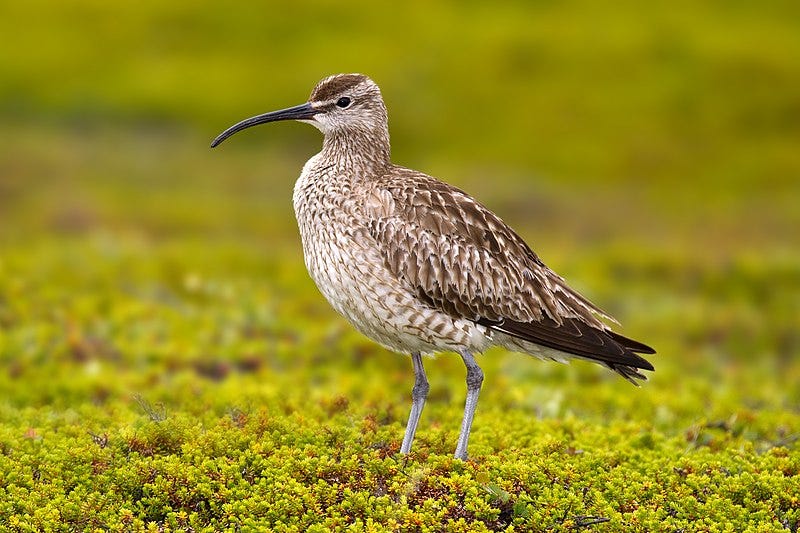I took to myself as pleasure
the gannet's noise and the voice of the curlew
instead of the laughter of men
~ The Seafarer (extract, translated from Old English)
As autumn deepens, the British coastline rings to the sound of curlews.
Curlews emit a range of shrill, characterful noises. The easiest to recognise is the one that we use to name them: a high, far-carrying ‘cor-leee’.
This is a sound many of us carry in memories of a chilly seaside walk. Curlews were made to stick their beaks in soft mud. Where there’s mud, revealed at low tide in great slabs across an estuary or harbour, there will most likely be curlews, feeding and calling.
Curlews step about rather more deliberately than most waders, befitting their large size and the care required to handle that extraordinary bill.
The bill’s great length and downward curve enable the curlew to winkle out their prey - shrimps, worms, shellfish - from above, at some distance, presumably in a way that no other species manages quite as well.
In the breeding season, curlews are birds of higher ground and it is their spring song that captures the imagination.
The song, delivered on the wing, is impossible to miss. It begins with a few cautious warm-up notes, which rapidly turn into a string of high, urgent, oscillating cries.
In this recording you can hear a mix of the song (beginning), the typical ‘cor-leee’ calls (33 - 45 seconds) and another raspy version of the call (56 secs onwards).
Whether you find the sound mournful or eerie or joyful (and many find it hard to choose) it has long been enmeshed with the experience of living in open landscapes all around Britain.
Like lapwings, curlews really aren’t all that fussy in their choice of neighbourhood. They need open areas with some cover for nesting and plenty of food - such as provided by meadows, pasture and heathland. Perhaps a few boggy tracts with soft ground to probe.
It’s a range of habitats that was, until the mid 20th century, pretty common and unremarkable across much of Britain and Ireland.
And yet, also like lapwings, curlew numbers have declined calamitously in recent years.
Some 60 thousand breeding pairs - a quarter of the global population - are still with us, mainly in Northern England and Scotland. But this is around a third fewer than in the mid-1990s, since when they have all but disappeared as a breeding bird from southern England, Ireland and Wales.
This seems to be down to two main factors: the widespread loss of suitable nesting areas to more intensive agriculture and other land uses, and relentless pressure from historically high numbers of predators such as foxes and crows. It’s a combination that appears very hard for curlews to cope with.
Curlews are long-lived birds, typically reaching 11 years but with one individual proven to have survived to the age of 32. Successful or not, pairs will return year after year to their favoured breeding grounds, but with so few young fledging they are unable to replenish their populations.
Many projects are now underway to stem the declines and restore curlews to some of their previous homes. You can probe deep into the ecology and conservation of curlews, and support their future prospects, through the tireless work of Curlew Action.
Meanwhile our winter population of curlews is still swollen by many thousands of birds from colder parts of Europe. They gather around our coastal marshes and shorelines, and keep those wistful, joyful, irreplaceable cries in our ears at least a while longer.
Curlew
Norman MacCaig
Yesterday, I saw a cousin of yours
a whimbrel,
that, when close to, looks like yourself
seen at a distance
But who could mistake its jittery call
for yours, brown bird, as you fly
trading bubbles of music
over the squelchy hillside?
Music as desolate, as beautiful
as your loved places.
mountainy marshes and glistening mud-flats
by the stealthy sea.
Keeping it curl: Whimbrel
Thanks for reading Shriek of the Week. Updates are less than weekly for now, reflecting the quieter season for birdsong in the UK, but there’s lots to dig into in the A-Z.
Now booking for 2024
~ Birdsong half-day walkshops - Stanmer Park (Brighton) and Herstmonceux Castle (nr Hailsham, East Sussex)
~ Birdsong Essentials (the 10-week course) - online - starting February 2024
Media credits:
‘Curlew’ as published in Voice-over (1988), Norman MacCaig’s final collection of poems
Curlew image by Premed Hajek via Pixabay
Whimbrel image by Andreas Trepte, CC BY-SA 2.5, via Wikimedia Commons






What a great choice for this edition, Charlie. Thank you!
I have a special fondness for curlews as they were the soundtrack to our move to The Ribble Valley. I had never consciously heard or seen them before. I somehow managed to find out what they were by typing in goodness knows what to Google. It's so sad how much their numbers have depleted. It makes me feel so fortunate that I can often hear and see them from our garden. I won't ever take this for granted.